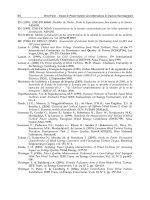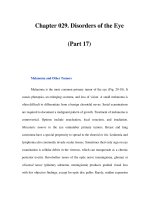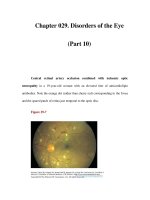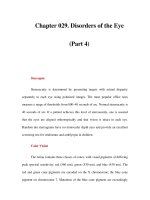Chapter 091. Benign and Malignant Diseases of the Prostate (Part 4) potx
Bạn đang xem bản rút gọn của tài liệu. Xem và tải ngay bản đầy đủ của tài liệu tại đây (16 KB, 5 trang )
Chapter 091. Benign and Malignant
Diseases of the Prostate
(Part 4)
Pathology
The noninvasive proliferation of epithelial cells within ducts is termed
prostatic intraepithelial neoplasia. PIN is a precursor of cancer, but not all PIN
lesions develop into invasive cancers. Of the cancers identified, >95% are
adenocarcinomas; the remainder are squamous or transitional cell tumors or,
rarely, carcinosarcomas. Metastases to the prostate are rare, but in some cases
colon cancers or transitional cell tumors of the bladder invade the gland by direct
extension. When prostate cancer is diagnosed, a measure of histologic
aggressiveness is assigned using the Gleason grading system, in which the
dominant and secondary glandular histologic patterns are scored from 1 (well-
differentiated) to 5 (undifferentiated) and summed to give a total score of 2–10 for
each tumor. The most poorly differentiated area of tumor (i.e., the area with the
highest histologic grade) often determines biologic behavior. The presence or
absence of perineural invasion and extracapsular spread are also recorded.
Prostate Cancer Staging
The TNM staging system includes categories for cancers that are palpable
on DRE, those identified solely on the basis of an abnormal PSA (T1c), those that
are palpable but clinically confined to the gland (T2), and those that have extended
outside the gland (T3 and T4) (Table 91-1). DRE alone is inaccurate with respect
to the extent of the disease within the gland, the presence or absence of capsular
invasion, involvement of seminal vesicles, and extension of disease to lymph
nodes. Because of the inadequacy of DRE for staging, the staging system was
modified to include the results of imaging studies. Unfortunately, no single test
has proven to indicate accurately the stage or the presence of organ-confined
disease, seminal vesicle involvement, or lymph node spread.
Table 91-
1 Comparison of Clinical Stage by the TNM Classification
System and the Whitmore-Jewett Staging System
TNM
Stage
Description Whitmore-
Jewett Stage
Description
T1a Nonpalpable,
with 5% or less of
resected tissue with
cancer
A1 Well
differentiated tumor on
few chips from one
lobe
T1b Nonpalpable,
with >5% of resected
tissue with cancer
A2 Involvement
more diffuse
T1c Nonpalpable,
detected due to
elevated
serum PSA
T2a
Palpable, half of
one lobe or less
BIN
Palpable, < one
lobe, surrounded by
normal tissue
T2b
Palpable, > half
of one lobe but not both
lobes
B1
Palpable, < one
lobe
T2c Palpable,
involves both lobes
B2
Palpable, one
entire lob
e or both
lobes
T3a Palpable,
unilateral extracapsular
extension
C1 Palpable,
outside capsule, not
into seminal vesicles
T3b Palpable,
bilateral extracapsular
extension
T3c
Tumor invades
seminal vesicle(s)
C2 Palpable,
seminal vesicle
involved
M1 Distant
metastases
D Metastatic
disease
Source:
Adapted from FF Schroder et al: TNM classification of prostate
cancer. Prostate (Suppl) 4:129, 1992; and American Joint Committee on Cancer,
1992.









